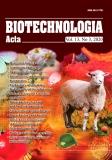ISSN 2410-7751 (Print)
ISSN 2410-776X (Online)

Biotechnologia Acta V. 13, No 3, 2020
Р. 81-88, Bibliography 15, English
Universal Decimal Classification: 628.3
https://doi.org/10.15407/biotech13.03.081
EFFECTIVE TECHNOLOGY OF PHARMACEUTICAL ENTERPRISES WASTEWATER LOCAL TREATMENT FROM ANTIBIOTICS
National Technical University of Ukraine “Igor Sikorsky Kyiv Polytechnic Institute”
The work was aimed to study the processes of industrial wastewater purification of a pharmaceutical company treatment and to recommend an effective technology for local treatment of such wastewater in accordance with the requirements of normative documents on the treated wastewater disposal into the urban sewerage system.
Model solutions of cefuroxime, a cephalosporin antibiotic, in distilled water with a concentration of 25 and 35 mg/dm3 were used for the study. COD model solutions, which is, respectively, 90 and 120 mg/dm3. Chemical oxygen demand was etermined by the dichromate method (according to the guiding normative document (GND) 211.1.4.021-95. “Methods for Chemical Oxygen Demand (COD) Determining in Surface and Wastewater”).
The proposed technology included the following successive processes of physical and chemical treatment of wastewater: aeration – equalization of quantitative and qualitative composition of wastewater and oxidation up to 30% of organic matter; coagulation – removing of antibiotics from wastewater by their adsorption on a highly developed surface of mineral coagulants flakes; sedimentation – separating of the formed flakes; oxidation of antibiotics destruction products by hydrogen peroxide; filtration – removal of fine impurities.Effect of COD reduction rate in the coagulation and setteling of wastewater in the case of ferrous sulphate III was 79.2% and 75%, which is higher by 4.2-6.7% than when using aluminum sulphate. The COD index changing of the pharmaceutical enterprise wastewater by the stages of its purification was found as follows: “aeration — coagulation with iron sulfate III — sedimentation — oxidation — filtration”. After filtering effect of reducing COD index was 95.8-100% at the initial value of 120 and 90 mg/dm3 respectively. The technology of local wastewater treatment from antibiotics was developed, which was based on the consistent use of physico-chemical methods of treatment and enabled to remove antibiotics and related substances from wastewater in accordance with the requirements of normative documents and disposal of treated wastewater into the urban wastewater system.
Application of the developed technology of local wastewater treatment from antibiotics and related substances by the pharmaceutical companies would lead to meet the requirements of industrial wastewater disposal into the city drainage system, to a significant risk reduction of the antibiotics influence on the microorganisms of active sludge of the urban wastewater biological treatment facilities, to operating costs reduction to achieve maximum allowable discharges (MAD) of wastewater into a natural reservoir.
Key words: antibiotics, wastewater, treatment, pharmaceutical enterprises.
© Palladin Institute of Biochemistry of National Academy of Sciences of Ukraine, 2020
References
1. Angeles L. F., Mullen R. A., Huang I. J., Wilson C., Khunjar W., Sirotkin H. I., McElroy A. E., Aga D. S. Assessing pharmaceutical removal and reduction in toxicity provided by advanced wastewater treatment systems. Environmental Science: Water Research and Technology. 2020, 6 (1), 62–77. https://doi.org/10.1039/C9EW00559E
2. Kurt A., Mert B. K., ?zengin N., Sivrio?lu ?., Yonar T. Treatment of Antibiotics in Wastewater Using Advanced Oxidation Processes (AOPs). Physico-Chemical Wastewater Treatment and Resource Recovery. 2017. https://doi.org/10.5772/67538
3. Collivignarelli M. C., Pedrazzani R., Sorlini S., Abb? A., Bertanza G. H2O2 based oxidation processes for the treatment of real high strength aqueous wastes. Sustainability (Switzerland). 2017, 9 (2), 1–14. https://doi.org/10.3390/su9020244
4. Ghaly M. Y., H?rtel G., Mayer R., Haseneder R. Photochemical oxidation of p-chlorophenol by UV/H2O2 and photo-Fenton process. A comparative study. Waste Management. 2001, 21 (1), 41–47. https://doi.org/10.1016/S0956-053X(00)00070-2
5. Ribeiro A. R., Sures B., Schmidt T. C. Cephalosporin antibiotics in the aquatic environment: A critical review of occurrence, fate, ecotoxicity and removal technologies. Elsevier Ltd. 2018. https://doi.org/10.1016/j.envpol.2018.06.040
6. Ahmed M. B., Zhou J. L., Ngo H. H., Guo W. Adsorptive removal of antibiotics from water and wastewater : Progress and challenges Science of the Total Environment Adsorptive removal of antibiotics from water and wastewater : Progress and challenges. Science of the Total Environment. 2015, 532 (November), 112–126. https://doi.org/10.1016/j.scitotenv.2015.05.130
7. Choi K. J., Kim S. G., Kim S. H. Removal of antibiotics by coagulation and granular activated carbon filtration. Journal of Hazardous Materials. 2008, 151 (1), 38–43. https://doi.org/10.1016/j.jhazmat.2007.05.059
8. Choi K. J., Kim S. G., Kim S. H. Removal of antibiotics by coagulation and granular activated carbon filtration. Journal of Hazardous Materials. 2008, 151 (1), 38–43. https://doi.org/10.1016/j.jhazmat.2007.05.059
9. Carabineiro S. A. C., Thavorn-Amornsri T., Pereira M. F. R., Figueiredo J. L. Adsorption of ciprofloxacin on surface-modified carbon materials. Water Research. 2011, 45 (15), 4583–4591. https://doi.org/10.1016/j.watres.2011.06.008
10. Adams C., Wang Y., Loftin K., Meyer M. Removal of antibiotics from surface and distilled water in conventional water treatment processes. Journal of Environmental Engineering. 2002, 128 (3), 253–260. https://doi.org/10.1061/(ASCE)0733-9372(2002)128:3(253)
11. Elbalkiny H. T., Yehia A. M., Riad S. M., Elsaharty Y. S. Removal and tracing of cephalosporins in industrial wastewater by SPE-HPLC: optimization of adsorption kinetics on mesoporous silica nanoparticles. Journal of Analytical Science and Technology. 2019, 10 (1). https://doi.org/10.1186/s40543-019-0180-6
12. Duan H. Study on the Treatment Process of Wastewater from Cephalosporin Production. Journal of Sustainable Development. 2009, 2 (2), 133–136. https://doi.org/10.5539/jsd.v2n2p133
13. Watkinson A. J., Murby E. J., Costanzo S. D. Removal of antibiotics in conventional and advanced wastewater treatment: Implications for environmental discharge and wastewater recycling. Water Research. 2007, 41 (18), 4164–4176. https://doi.org/10.1016/j.watres.2007.04.005
14. Suslova O. Resistance of karst caves microorganisms to p-nitrochlorobenzene. Biotechnol. acta. 2015, 8 (4), 135–140. https://doi.org/10.15407/biotech8.04.135
15. Tashyrev O. Natural and synthetic solid carriers in flow module for microbial sewage filtrate purification. Biotechnol. acta. 2018, 11 (6), 73–81. https://doi.org/10.15407/biotech11.06.073

